| The Birmingham Canal
Navigations The canal was built to transport
coal from the Black Country coalfields in the Wednesbury
area into Birmingham. James Brindley surveyed a possible
route in 1767 and in the following year an Act of
Parliament was Passed to allow the construction to go
ahead. The route followed Brindley's survey from
Birmingham to Wednesbury, then on to Bilston via Bradley
and to Wolverhampton and Aldersley Junction on the
Staffordshire & Worcestershire Canal.
|
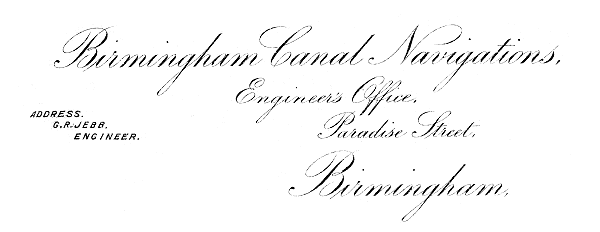
A company letterhead.
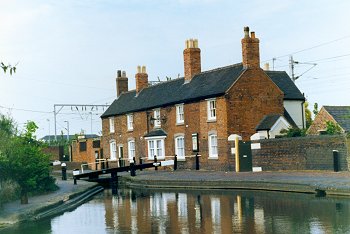
Broad Street Basin, Wolverhampton
and the first lock in the flight of 21 down to Aldersley
Junction. |
The circuitous route followed the natural contours
to avoid as much large-scale engineering work as
possible, and the total distance of 12½
miles as the crow flies was covered in just over
22½ miles.
After the Act had been
Passed, James Brindley was appointed as engineer to the
newly formed Birmingham Canal Company, and work soon got
underway. The section from Birmingham to Wednesbury
opened on 6th November, 1769 and the canal reached
Wolverhampton in August 1771. |
| All that now remained
was the difficult 1½ mile section to Aldersley Junction
which involved a drop in height of about 150ft. It
required a flight of 21 locks and took about 13 months
to complete. During this time relations between the
Birmingham Canal Company and the Staffordshire &
Worcestershire Canal Company became somewhat strained,
because the Birmingham canal didn't reach Aldersley
Junction until 4 months after the opening of the Staffs
& Worcs Canal. This section opened on 21st September,
1772, just 8 days before Brindley's death. |
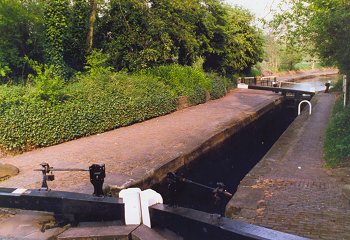
The last lock (number 21) before
Aldersley Junction. |
| The Birmingham canal
was a great success. Large quantities of coal,
limestone, sand and Rowley ragstone were transported far
more cheaply and quickly than ever before, benefiting
both the canal company and the mining companies alike.
The canal company would go on from strength to strength
as the canal expanded and other canal companies were
taken over.
The Birmingham & Fazeley Canal
The canal was originally planned in 1782 to connect
the Black Country coalfields around Wednesbury to
Coventry, in order to capture some of the lucrative coal
haulage work from the Birmingham Canal Company. |
|
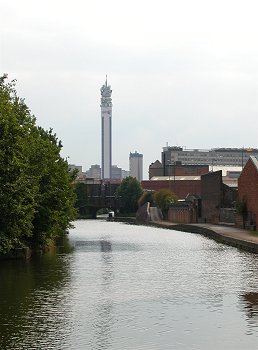
The Birmingham & Fazeley Canal. |
The two canals would be in direct competition and
this resulted in many battles in Parliament as the
Birmingham Canal Co. vigorously opposed the new venture.
Eventually an agreement was reached and the proposed
route was shortened to run from the Coventry Canal to a
junction with the Birmingham Canal in the centre of
Birmingham. This ensured that the coal traffic would
still use the Birmingham Canal and the company's profits
would not be affected by the new venture. The
Birmingham & Fazeley Canal opened for business in 1789,
but through traffic was not allowed until the agreement
between the two companies was finalised in 1790. The new
canal became an instant success and the two companies
joined forces in 1794 to become the Birmingham Canal
Navigations (BCN). |
|
The Wyrley & Essington
Canal The Wyrley & Essington canal was planned
to link the coalfields of Wyrley and Essington to the
Birmingham Canal at Wolverhampton. An Act of Parliament
was Passed on 30th April, 1792 to allow the work to
commence. Much of the finance came from Wolverhampton
businessmen, principally the Molineux family. Work soon
started under the canal company's engineer, William
Pitt. There were two branches, one to a colliery at
Essington and the other to Birchills near the centre of
Walsall. The canal joined the Birmingham Canal at
Horseley Fields and opened on 8th May, 1797. Being a contoured canal and following an
extremely circuitous route, it became known as "The
Curly Wyrley". The
Walsall Canal
On 17th April, 1794 an Act of Parliament was
Passed to allow work to begin on an extension of
the canal from Wednesbury to Walsall via Darlaston. |
| In 1799
the Walsall Branch of the Birmingham Canal
Navigations opened from Walsall to Moxley, and
the entire canal opened for business in 1809. One of the larger features is the James Bridge
aqueduct which carries the canal over Bentley
Mill Way and the River Tame. It was completed in
1799 and is now a listed building. |

James Bridge Aqueduct. |
|
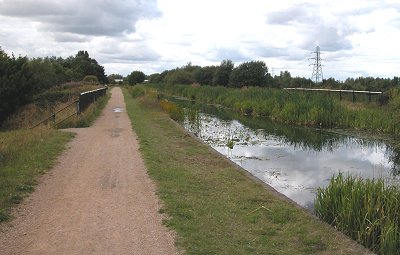
Walsall Canal above James
Bridge Aqueduct. |
The Anson Branch from the Walsall Canal at
James Bridge to coalmines and a quarry at
Bentley opened in 1830 with an extension (the
Bentley Canal) to the Wyrley & Essington Canal
at Wednesfield.
In 1841 an extension was built between the Walsall Canal
at Walsall and the Wyrley and Essington Canal at
Birchills Junction. |
| The
Dudley No. 2 Canal This was planned
in 1792 to connect the quarries at Netherton
to the Worcester & Birmingham Canal at Selly
Oak. |
| An Act of Parliament was Passed in
June 1793 and work got underway under
the supervision of the company's
engineer John Snape. Unfortunately he
died in 1796 and so his assistant
William Underhill took over. The canal
ran from the Dudley Canal for nearly 11
miles, just over 2 miles of which ran
through a tunnel at Lapal. The canal
suffered from many problems, mainly due
to subsidence. The Lapal tunnel had to
be closed in 1917 following a roof fall. |
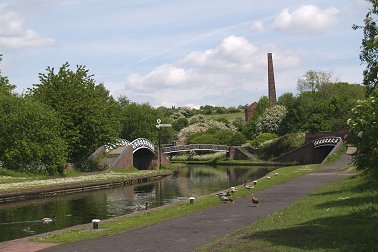
The Dudley No. 2
Canal near Netherton. |
|
The BCN Main Line By the
1820s the BCN carried a lot of
traffic which was greatly hampered
by the 22½
mile circuitous route. Something had
to be done to speed the flow of
traffic and so in April 1824 the
engineer Thomas Telford was engaged
to survey the canal with the idea of
shortening and improving the route. |
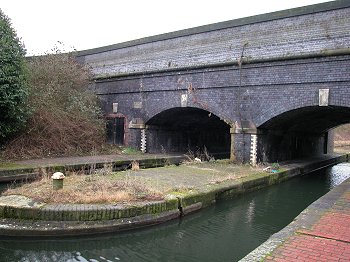
The
aqueduct carrying Brindley's old
canal over one of the offshoots
of Telford's main line;
the Netherton Tunnel Branch. |
In
his report of December, 1824 he
recommended that many of the
bends should be cut off and a
new straight line be built
between Smethwick and Bloomfield
which would shorten the canal by
7 miles, and remove the locks.
He also recommended that a
reservoir should be built at
Rotton Park. Work on the
improvements began in 1826 but
it took until 1838 for
everything to be completed,
mainly because of lack of funds
for the very expensive work. |
|
On 5th February, 1840 the
BCN amalgamated with the Wyrley & Essington Canal and in
1845 the BCN was leased by the London & Birmingham
Railway, and from 1846 by its successor the London &
North Western Railway.
Also in 1846 the BCN
amalgamated with the Dudley Canal (Dudley No. 1) and the
Dudley No. 2 Canal. |
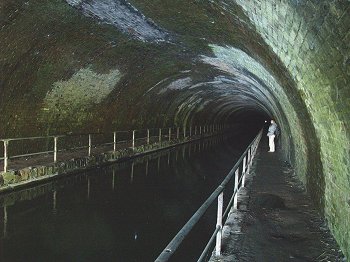
The
Netherton Tunnel. |
|
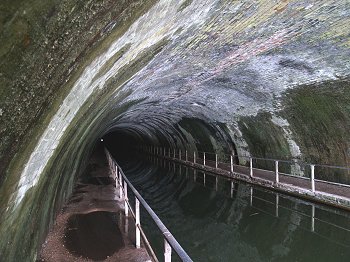
Another view of the
Netherton Tunnel. |
This would eventually be
good news for the Dudley No. 2 Canal because in 1858 the
Netherton Tunnel opened to provide a direct link to the
BCN and remove the bottleneck caused by the narrow
Dudley tunnel and the Lapal tunnel.
Work began on the 27ft.
wide, 3,027 yards long
Netherton Tunnel in December
1855. The new tunnel allowed
the use of two-way traffic
and so was a great
improvement over the two
one-way tunnels. |
|
The Tame Valley Canal
The Tame Valley Canal runs
from Doe Bank junction on the BCN to Salford Junction on
the Birmingham & Fazeley Canal. |
|
Work on the project, one
of the last new canals
to be constructed in the
Black Country, began in
1839 and took five years
to complete. There were
many engineering
difficulties to
overcome.
Building works included
high embankments, the
Piercy Aqueduct,
Spouthouse Lane
Aqueduct, and 13 locks.
The canal opened for
business on 14th
February, 1844. |
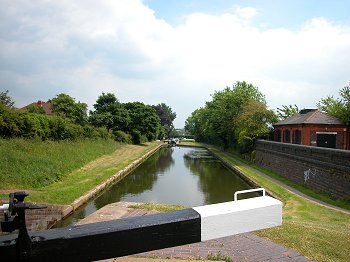
One of the locks on the
Tame Valley Canal. |
 |
Return to the Canals
and Industry Menu |
|